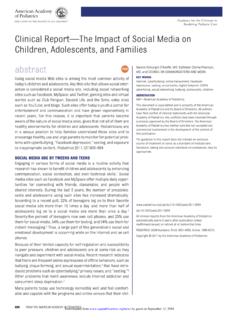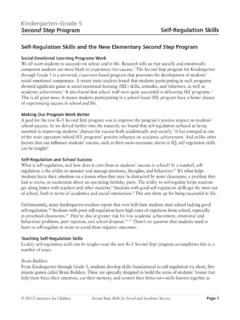Transcription of Institute of Applied Social Studies School of Social …
1 1 Institute of Applied Social Studies School of Social Policy Maturity, young adults and criminal justice: A literature review David Prior Kathryn Farrow Nathan Hughes Gill Kelly Gary Manders Sue White Bernadette Wilkinson March 2011 Commissioned by the Barrow Cadbury Trust for the Transition to Adulthood Alliance 2 Contents 1. Introduction 1 2. Maturity and offending: the research literatures 3 3. Maturity in neuroscientific research 5 4. Maturity in psychological research 7 5. Maturity in criminological research 15 6. Gender and ethnicity in maturity research 19 7. Supporting desistance from offending 21 8. Assessing maturity in the criminal justice system 26 9. International practices 30 10. Conclusions 33 Appendix: Review Methodology 34 Bibliography 35 3 Maturity, young adults and criminal justice: A literature review 1.
2 Introduction This report presents findings from a review of research and other literature relating to the issue of the maturity of young adult offenders, its measurement and its relevance to the criminal justice system in England and Wales. Brief details of the methodology used to conduct the review are given in the Appendix. Two preliminary points need to be made. First, the focus of the review is on young adults, that is, people aged 18-24 years. In the criminal justice system of England and Wales, as in most Western jurisdictions, criminal offenders in that age group are treated simply as adults, and not identified as a distinct age group in law. This contrasts with young people who are above the age of criminal responsibility (10 years in England and Wales) but below the age of 18: they are dealt with through the youth justice system, which provides a range of responses specific to that age group. This distinction is substantially carried through into academic and policy research, with the effect that research tends to focus either on under-18s or on adults as an undifferentiated group.
3 Insofar as the research interest is on the question of maturity, most Studies are concerned with young people under the age of 18 and thus with the relationship between maturity and juvenile crime . Although there are exceptions, comparatively little research has focused specifically on the maturity of young adults; where it has, however, some powerful conclusions are drawn and are highlighted in this report. Second, the review has identified distinct bodies of research literature concerned with maturity and crime, separated by disciplinary boundaries, involving different theoretical models and analytical concepts, and distinctive methodological approaches. In particular we have identified three major bodies of literature that we consider relevant to the review topic: neurological, psychological and criminological. Differences between these approaches are discussed in section 2. Although there are instances of Studies and commentaries that make connections across these bodies of work (and these are discussed in our review), for reasons of clarity of presentation this report is largely structured around those three disciplinary headings.
4 There are however two additional sections that deal with the more Applied topics of support for desistance and tools for assessing maturity , and a brief section on international experiences in responding to young adult offenders. The concept of maturity The concept of maturity is central to this review, and it is therefore important to begin with an attempt to understand the meanings that the concept carries in the research and policy literature concerned with crime and criminal justice1. This is not entirely straightforward. In a review of relevant research published in 1996, two of the leading American scholars in the field noted that maturity is a remarkably elusive and ill-defined construct among legal scholars and Social scientists (Steinberg and Cauffman 1996: 251). Since then, a very considerable amount of research-based 1 There is a much wider academic literature concerned with maturity and its significance for a range of contexts, but we have necessarily limited this review to that which focuses on the relationship between maturity and crime.
5 4 literature has been published that, directly or indirectly, engages with the issue of maturity, and this provides the substance of this report. As will be shown, however, the concept does in many ways remain elusive, in large part because maturity cannot be considered a wholly objective, measurable concept but contains an inescapably normative dimension. A starting-point is with Studies of the process of individual human development, which encompasses the categories of physical, intellectual, emotional and Social development (Steinberg and Schwartz, 2000). Ideas of maturity and immaturity may be Applied to each of these categories. Whilst it is recognised that change and development across these categories occurs throughout the lifespan, introducing the notion of maturity tends to focus attention on the processes through which a young person reaches the status of adulthood. From the perspective of this review s concern with young adults aged 18-24 years, the different developmental categories are of varying significance.
6 Thus, most young people will become physically mature during mid-adolescence; some will be physically mature at age 12 or 13, although others may not complete puberty until they are 18 or 19 (Vizard 2006). Generally speaking, the issue of physical maturity/immaturity is not likely to be a significant factor in the criminal justice response to young adult offenders. A similar point can be made about intellectual maturity. Although the potential for lifelong learning is a reality, the most profound changes in intellectual capacities occur in the period from birth to late adolescence (Vizard 2006), and there is a broadly accepted view that an individual s intellectual abilities will have matured to adult levels before the age of 18 (Steinberg and Schwartz 2000). It is of course the case that young adults may have intellectual capacities significantly below the adult norm, indicated by low IQ scores and a range of potential learning disabilities.
7 Given the research evidence of a strong association between low IQ and delinquency (Rutter et al 1998), this is a major issue for the criminal justice system in its own right. It is the remaining categories of emotional and Social development that seem to be of greatest relevance to the way the maturity of young adults should be considered within the criminal justice system, for reasons that are set out below. They are also categories of considerable complexity and, often, ambiguity; in part because of their interaction with each other and with the process of intellectual/cognitive development. Much of this report is concerned with an exploration of what different types of research tell us about the emotional and Social maturity of young adult offenders, as reflected in forms of behaviour. The neuroscientific research, discussed in section 3, is different in that its focus is not on overt behaviour, but on processes of physiological maturation in the cognitive functions of the brain which regulate responses to emotional impulses and Social interactions.
8 Key messages: Maturity can be understood as a developmental concept, including the categories of physical, intellectual, emotional and Social development. Processes of physical and intellectual development are usually completed during adolescence; it is the categories of emotional and Social development that are of most relevance in considering the maturity of young adults. 5 2. Maturity and offending: the research literatures It became apparent quite early in the review process that the concept of maturity is used explicitly in two distinct bodies of research literature concerned with antisocial or criminal behaviour. These are, firstly, neurological Studies of brain development, highlighting the structural and functional changes that occur as the human brain matures and the implications of this for understanding behaviour; and secondly, psychological Studies of the development of maturity in adolescents and young adults and its relationship to attitudes and behaviours.
9 Thus, in both these bodies of work, maturity is a core developmental concept and the direct focus of research attention. Key findings from the neuroscientific and psychological Studies of maturity are presented below in sections 3 and 4. However, it also became clear that while other approaches to the study of offending by young adults, and of the response of the criminal justice system to such offending, do not use an explicit concept of maturity as part of their explanatory framework, they do use concepts that seem to be closely related to, or stand as surrogates for, ideas and meanings contained in the psychological concept of maturity. Two of these approaches are extremely influential in criminological research: The general theory of crime developed by Gottfredson and Hirschi (1990), which proposes that self-control is the key explanatory concept in accounting for criminal behaviour. The risk factors approach of developmental criminology, in which individual or personality factors such as impulsivity , empathy or moral judgement are deployed alongside Social and cultural factors such as socialization processes, peer relations and neighbourhood influences.
10 These approaches, their relationship to the concept of maturity and their implications for criminal justice responses to young adult offenders are considered in section 5. It is important to be aware that these different bodies of research the neurological, psychological and criminological tend to use quite different research designs and methodologies to generate their findings, they often have different understandings of the objects of scientific investigation, of the techniques that should be used to produce evidence, of what counts as valid evidence and of the kinds of theories that can explain that evidence. Thus, to over-simplify rather crudely, psychological approaches focus on individual behaviour, the mental processes that influence that behaviour and the reasons why those behaviours and mental processes vary between individuals; and typically use either experimental methods of investigation (involving statistical comparisons of outcomes between experimental groups and control groups) or statistical analysis of differences between distinct groups identified within large scale surveys.











